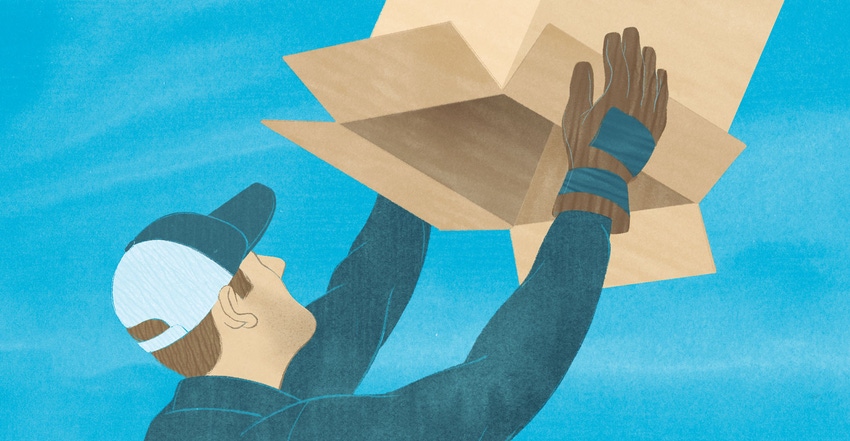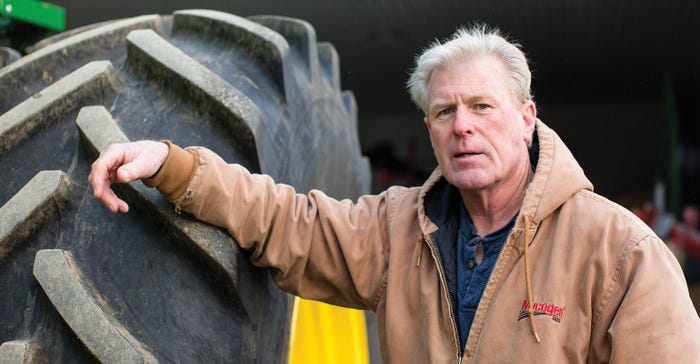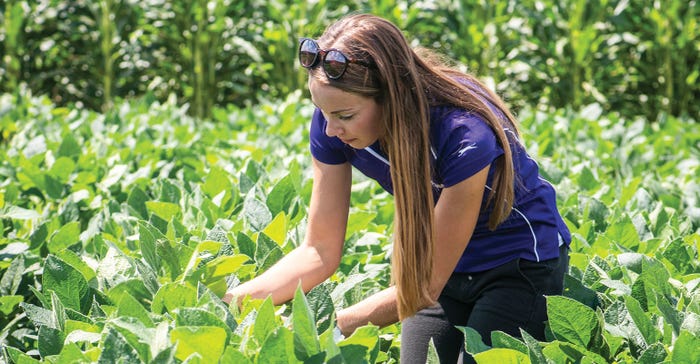
Fertilizer prices rocketed significantly higher throughout the summer and fall, creeping dangerously close to record levels. On top of that, rumors of herbicide shortages and supply chain disruptions are swirling. The situation has left more than a few farmers wondering how to plot out the 2022 season amid so much uncertainty.
From the “Sky is falling!” to “What, me worry?” there are a broad range of reactions to the current situation. The middle ground may be the smartest play. Forge ahead, put together plans B and C, and be aware of all the risks as you make decisions on next year’s crops.
What happened, exactly? It’s complicated, but here are some lowlights:
Weather woes
With its 150-mph winds pounding the Gulf Coast, Hurricane Ida damaged river barges and knocked out production at a glyphosate plant in Louisiana in late August and early September.
Supply slowdowns
Pandemic-related supply chain stoppages worldwide continue to raise havoc. “A single case of COVID could shut down an entire port in China for days,” notes Ken Eriksen, senior vice president of agribusiness with IHS Markit. “But in addition to COVID, you had gaps in supplies, the containers weren’t available, the ships weren’t sailing, and it was hard to keep up with labor needs to either manufacture goods or move them.”
Tariff troubles
Tariffs have further limited supplies. For example, tariffs levied against Russian and Moroccan phosphate (which is heavily subsidized) were intended to level the playing field, but that plan has largely backfired because Russia just sells its product to countries that haven’t imposed tariffs, explains Farm Futures grain market analyst Jacqueline Holland. “The U.S. has struggled to find affordable phosphate suppliers since the tariffs were levied against Russia and Morocco. The resulting shortages have played a key role in rising prices,” she says.
Add it all up — shutdowns, shortages and the logistical log jams — and Holland severely doubts fertilizer and input prices will go down between now and next spring, at the very earliest. But that’s not the only concern.
“It’s not enough to think about this from a cost standpoint,” she says. “You can’t afford to delay planting, harvesting and other key operations in the growing season. Stoppages put yields and grain quality at risk.”
When things get back to “normal” is unknown, but Kenneth Scott Zuckerberg, senior economist at CoBank, says current troubles could reach into planting season.
“We’ve gotten credible information that agrochemicals — both branded and generic herbicides, and other products produced in Asia — are experiencing major production backlogs,” he says. “So crop protection chemicals, in particular, is an area that will likely be short going into the spring agronomy season.”
Farmer frustrations
With this level of uncertainty the best advice is to overcommunicate with business partners. Illinois farmer Stan Born has been checking in with retailers, who haven’t expressed availability concerns yet.
“I have not made radical changes,” he says. “It’s business as usual for now; I order in the fall and prepay. But I am concerned about fertilizer prices — it’s frustrating.”
Born says he plans inputs for the following year each fall. His operation isn’t large enough to secure volume discounts, so at least he can take advantage of early discounts.
“If I can pay forward and have good cash flow, then I can take care of things in the fall, regardless of potential shortages in the future,” he says. “One thing is certain, you can never get complacent.”

Illinois farmer Stan Born says he hasn’t run into any supply chain issues on his operation yet, but he has been in regular contact with his retailers in case any changes occur and alternate plans for 2022 inputs are needed.
Michigan farmer Mark Kies has been taking availability concerns seriously and has been closely monitoring price trends.
“We’re trying to stay on top of it,” he says. “But prices are nearly double from what they were a year ago. Still, if you can take delivery now, do it.”
Unfortunately, that’s not an option for spring liquid fertilizer because Kies doesn’t have the capacity to store all of his needs on-farm.
“We don’t know if it will be available, and that’s a challenge,” he says. “If suppliers don’t get it, we won’t get it.”

Michigan farmer Mark Kies says it’s been very hard to budget for 2022, with some fertilizers nearly doubling in price from a year ago. “We’re trying to stay on top of it,” he says, adding “if you can take delivery now, do it.”
Force majeure
Even farmers who signed contracts with their retailers aren’t necessarily guaranteed delivery on what they were promised, adds Brianna Schroeder, an attorney with Indiana-based Janzen Schroeder Agricultural Law LLC. That’s because of a little-known area of contract law called “force majeure,” which many more people are going to become familiar with this coming year.
Force majeure has typically been an oft-included but little-enforced clause that allows for that contract to be altered or abandoned if an unforeseeable event out of one or both party’s control prevents promises from being fulfilled, Schroeder explains.
“What’s really interesting is these provisions have been boilerplate on contracts for years, and no one has hardly ever gotten hung up on it,” she says. “It just gets put in there, and people never really thought about it.”
In the pandemic era, Schroeder has seen plenty of force majeure disputes emerge, particularly for perishable goods.
Many times, those quarrels came about following government-enforced shutdowns of restaurants, which then didn’t want to take delivery on milk, meat, vegetables and other perishable goods.
Whether force majeure becomes a significant headache in the ag retail space remains to be seen. But time is still on your side, Schroeder says.
“It’s worth it to ask your suppliers questions ahead of time,” she says. “Then it’s not an unforeseen issue because we’re talking and planning about it. Because we have months to plan, what’s in place to ensure everything goes forward as designed?”
Retailer response
Just as farmers are trying to develop more proactive input plans ahead of the 2022 season, retailers are working to make sure things go as smoothly as possible on their end. Communication will be especially important moving forward, according to Kaitlin Flick, district agronomist with MFA.
“I’d strongly encourage planning ahead and having the conversation with your retailer about your plans, yield goals and products you want,” she says. “Be as upfront as possible.”
Lower input availability and higher prices may prompt growers to make decisions outside their typical spray program, says Chris Bowley, customer and brand marketing manager with Nufarm.
“Reducing crop protections entirely won’t pay off at harvest, so growers will need to consult their ag suppliers or crop consultants for alternative active ingredient recommendations,” he says.
Flick agrees. Now is a great time to learn more about what crop chemicals are labeled for which pests, along with any known resistance. Read product labels. Know which active ingredients are duplicated across multiple brands.
“There are still a lot of great products on the market that are still available that aren’t glyphosate or 2,4-D,” Flick notes.

Kaitlin Flick, district agronomist with MFA, reminds farmers there may be some workarounds even amid potential product sources, such as looking at other brands that carry the same active ingredient or are labeled for the same pest types.
There are other strategies that can stretch your input dollar. Flick points to N stabilizers as one example, which can minimize losses from fall fertilizer applications that would otherwise be more prone to volatilization. There is also broad speculation across the industry that farmers will be open to trying biological products that may be able to unlock nutrient availability or boost nutrient uptake.
And Zuckerberg argues that now is the time to jump into the world of precision ag and variable-rate applications for those who aren’t already doing so.
“If there are tools and technology available to help you apply only what you need, now is an ideal time to adopt [variable-rate] technologies,” he says. “If you need to conserve because products are in short supply, there’s tech to do that. If you only have half of the fertilizer you need, it doesn’t make sense to apply it the same old way.”
Making changes can be painful, but having an open mind could be a profitable approach to the amount of uncertainty lurking in the supply chain this year.
“People get comfortable and build trust with certain products,” Flick says. “It’s still important to be a good steward and switch up modes of action. This is also an opportunity to start working year-round with a crop consultant or local agronomist. They can help design a plan, and retailers will know what you need and when you need it.”
Additional advice
What else should farmers be considering during these uncertain times? Holland has a few ideas.
First, make sure that any cuts to your fertility program don’t lead to yield losses down the road. Even with higher costs, pushing fertilizer rates too low may not be worth the yield sacrifice. That would be like cutting off your arm to take care of a paper cut on your finger, Holland quips.
Second, pencil out what’s truly feasible for your 2022 crop rotation: “Figuring out crop budgets now instead of the spring will help growers capture any cost savings, even if they are slim this year.”
Third, book some sales for the 2022 crop. “These prices [as of mid-October] are comfortably above breakeven levels, and we know we’re heading into an environment where we’ll see higher grain supplies.”
Holland doesn’t predict these runaway fertilizer prices will last forever, but it will take time to recover. Recall that mining companies had scaled back production as recently as 2019 due to a glut of excess fertilizer on the world market.
“Expansion signals are definitely there [for fertilizer companies], but it takes time for the fertilizer industry to adapt to rapid demand shifts, labor shortages and supply chain bottlenecks,” Holland says. “From a farmer’s standpoint, things will eventually calm down.”
In the meantime, patience will be a virtue, Eriksen says.
“Don’t overdo it, and don’t overextend yourself,” he says. “Pushing the pencil will be important. Develop a good budget, and stick to farming as best you can.”
Looking ahead
When will the tides shift back to more reasonable prices? Eriksen suggests a few things to track, starting with the price of natural gas, which is a major cost contributor to producing urea and other inputs.
Ocean freight rates are also important. Future infrastructure failures similar to the ones Hurricane Ida caused could present an unwelcome wildcard as well.
Farmers may be stuck between the proverbial rock and a hard place in the meantime, but they’re bracing themselves for the tough decisions that may lie ahead.
“I’m probably not going to cut back on fertility next year,” Born says. “I’m going to take care of the ground even if it costs more. If it’s what the crop needs, it’s what I’m going to do.”
5 questions your retailer wants to ask you
According to a recent blog post by Winfield United, locking in prices and inventory as early as possible will be even more critical this year. The best way to do that is to be in regular contact with suppliers. Retailers better serve their customers when they have enough time to plan and coordinate logistics on their end.
With that in mind, your retailer wants to know your answers to the following five questions:
What are your intentions for next year?
Will you be adding any more acres?
Are you making any major changes to your operation?
What are your crop rotation plans?
Which soybean trait platforms are you likely going to plant?
About the Author(s)
You May Also Like






